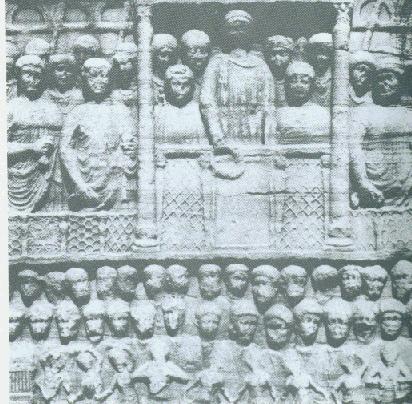The Egyptian Obelisk
and the Hippodrome
The Hippodrome was built by Severus at the beginning of the third century. It was later extended considerably by Constantine when he adopted and rebuilt the old city of Byzantium as his capital in 326 CE. It was here, under Justinian, in the 6th century that the slaughter of 40,000 rebels of the Greens and Blues (at one time just the distinguishing colours of the two racing teams, but later devoloping political affiliations and connotations), at the time of the Nika riots took place.
The dimensions of a hippodrome were very nearly standard; they were designed, after all for chariot races so they needed to be fairly long - the word hippodrome is derived from two Greek words meaning more-or-less "horse" and "race". It was about 450 to 500 yards long and over 100 yards wide. Down the middle was a central raised "spina". One end of the arena was semi-circular while the other was usually straight. There was supposed to have been a hippodrome in Jerusalem during Roman times but no archæological evidence has yet been found, in spite of the assurances given by Josephus in his writings. Recent excavations have, however, unearthed convincing evidence of a hippodrome at Cæsarea.
The hippodrome in Constantinople sat an estimated 40,000 spectators. My picture shows several items of interest: The Egyptian obelisk in the foreground - my main point here - was brought by Theodosius from Deir-el-Bahri, in Egypt, at the end of the 4th century. It was originally erected by Thutmose III, - and here is my point! - he who conquered most of Canaan at the beginning of the 15th century BCE, including Megiddo (Armageddon), Yokne'am, Bet-She'an, Acco, Jaffa, Ashkelon (Migdal), Damascus and over 80 other walled cities in the eastern Mediterranean countries - mainly the Holy Land.
The obelisk rests on four bronze blocks which themselves are on a plinth with scenes carved on all four sides (see below).
In the background, slightly to the left, can be seen the Fountain presented to the Sultan by Kaiser Wilhem II, at the time of his historic visit in 1898. Click here for more information.
Over to the right of the obelisk is the unmistakable Hagia Sophia

.....and perhaps another view?

.....and maybe even some more?


The marble bas-relief on the east side, above right, shows the Emperor about to hand the winner's wreath to the victor.

Back to The Byzantine Empire Back to Home Page




